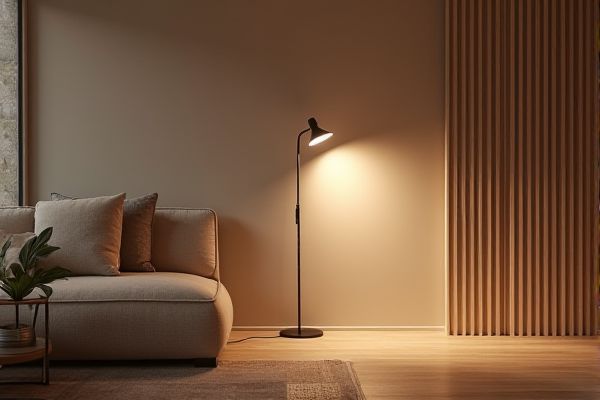
Wall-mounted lighting saves floor space and provides focused illumination ideal for task areas, while floor lighting offers flexibility and ambient light that can be easily repositioned to suit different moods. Discover which lighting solution best fits Your space and lifestyle by reading the rest of the article.
Table of Comparison
| Feature | Wall-Mounted Lighting | Floor Lighting |
|---|---|---|
| Installation | Fixed to walls, requires mounting hardware | Freestanding, easy to move and reposition |
| Space Usage | Saves floor space, ideal for small areas | Occupies floor space, may limit movement |
| Lighting Direction | Usually directional or ambient wall lighting | Provides ambient, task, or accent lighting |
| Design Flexibility | More permanent, less flexible | Highly flexible, portable lighting option |
| Maintenance | Harder to access for bulb replacement | Easy access for changing bulbs or cleaning |
| Safety | Minimizes tripping hazards | Potential tripping risk due to cords/bases |
| Power Source | Usually hardwired or plugged near walls | Requires nearby power outlet or battery operated |
| Application | Hallways, bathrooms, accent walls | Living rooms, reading nooks, flexible lighting |
Introduction to Wall-Mounted and Floor Lighting
Wall-mounted lighting offers targeted illumination while saving floor space, making it ideal for smaller rooms or accenting specific areas. Floor lighting provides versatile placement options and can enhance ambient lighting or highlight decor elements throughout your space. Choosing between these lighting types depends on your room size, design preferences, and functional needs.
Key Differences Between Wall-Mounted and Floor Lighting
Wall-mounted lighting offers targeted illumination fixed at a higher elevation, ideal for accentuating artwork or providing ambient lighting without occupying floor space. Floor lighting provides flexible, movable sources of light that can highlight pathways or create cozy atmospheres, often used as task or accent lighting in living areas. The key differences lie in installation permanence, spatial footprint, and the directionality of light, influencing their functional and aesthetic applications in interior design.
Aesthetic Impact on Interior Design
Wall-mounted lighting enhances your interior design by creating focused illumination that highlights artwork and architectural details, adding depth and dimension to your space. Floor lighting contributes a cozy ambiance by casting warm, diffused light that complements furniture arrangements and softens room contours. Choosing between the two depends on the desired visual effect and functional needs of your interior layout.
Space-Saving Benefits and Considerations
Wall-mounted lighting maximizes floor space by eliminating the need for bulky lamp bases, making it ideal for small rooms and minimalist designs. Floor lighting offers flexibility in placement and portability but requires sufficient floor area and can create clutter in tight spaces. Choosing between these options depends on balancing spatial efficiency with lighting needs and room layout.
Lighting Effectiveness and Coverage
Wall-mounted lighting provides targeted illumination that enhances specific areas with focused brightness, making it ideal for task lighting and accentuating architectural features. Floor lighting offers broader coverage and flexible positioning, creating ambient light that fills larger spaces and adjusts easily to changing room layouts. Both options contribute to balanced lighting schemes when combined, optimizing effectiveness and coverage throughout a room.
Installation and Flexibility
Wall-mounted lighting offers a space-saving installation with fixed placement, ideal for consistent illumination and minimal floor clutter. Floor lighting provides greater flexibility, allowing easy repositioning and adjustment to suit changing room layouts and ambiance preferences. Installation of wall-mounted fixtures typically requires professional wiring and mounting, while floor lamps require no installation beyond plugging in.
Energy Efficiency Comparison
Wall-mounted lighting typically offers higher energy efficiency due to targeted illumination that reduces wasted light and uses lower wattage bulbs. Floor lighting often requires higher lumens to effectively brighten larger areas, increasing overall energy consumption. Choosing LED technology in both types can significantly enhance energy savings, but wall-mounted fixtures generally achieve better efficiency in energy use per lumen output.
Maintenance and Longevity
Wall-mounted lighting typically requires less frequent maintenance due to its fixed, elevated position, reducing exposure to dust and physical damage compared to floor lighting. Floor lighting is more prone to wear and tear from foot traffic and cleaning activities, necessitating regular checks and bulb replacements to maintain performance. Proper installation and choosing high-quality, durable fixtures can significantly extend the longevity of both wall-mounted and floor lighting systems.
Cost Analysis: Upfront and Long-Term
Wall-mounted lighting generally involves lower upfront costs due to simpler installation and less material usage compared to floor lighting, which often requires more extensive wiring and sturdier fixtures. Long-term expenses for wall-mounted lights tend to be lower as they typically use energy-efficient LED bulbs and reduce the need for frequent replacements caused by accidental damage common to floor lamps. Your choice should consider both installation costs and durability, with wall-mounted options providing a cost-effective, long-lasting lighting solution.
Choosing the Right Lighting for Your Space
Wall-mounted lighting offers targeted illumination and saves floor space, making it ideal for small rooms or areas requiring focused light, such as reading nooks or hallways. Floor lighting provides versatile, movable options that can create ambiance and highlight architectural features, suitable for larger living areas or rooms where flexibility is important. Assess your room size, functional needs, and design preferences to determine whether wall-mounted or floor lighting best enhances your space's atmosphere and usability.
 homyna.com
homyna.com